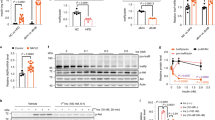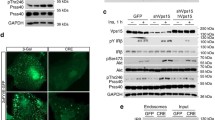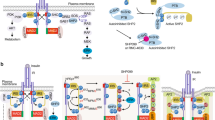Evidence indicates that endosomal insulin receptor (IR) trafficking plays a role in regulating insulin signal transduction. To evaluate its importance, we developed a series of biokinetic models for quantifying activated surface and endosomal IR dynamics from published experimental data. Starting with a published two-compartment Fao hepatoma model, a four-pool model was formulated that depicts IR autophosphorylation after receptor binding, IR endosomal internalization/trafficking, insulin dissociation from and dephosphorylation of internalized IR, and recycling of unliganded, dephosphorylated IR to the plasma membrane. Quantification required three additional data sets, two measured, but unmodeled by the same group. A five-pool model created to include endosomal trafficking of the nonphosphorylated insulin-IR complex was fitted using the same data sets, augmented with another published data set. Creation of a six-pool model added the physiologically relevant dissociation of insulin ligand from the activated endosomal IR. More importantly, all three models, validated against additional data not used in model fitting, predict that, mechanistically, internalization of activated IR is a rate-limiting step, at least under the receptor saturating conditions of the fitting data. This rate includes the transit time to a site where insulin dissociation from and/or dephosphorylation of the IR occurs by docking with protein-tyrosine phosphatases (PTPases), or where a sufficient conformational change occurs in the IR, perhaps due to insulin-IR dissociation, where associated PTPases may complete IR dephosphorylation. Our new models indicate that key events in endosomal IR trafficking have significance in mediating IR activity, possibly serving to regulate insulin signal transduction.








Similar content being viewed by others
REFERENCES
Akaike, H. A new look at the statistical model identification. IEEE Trans. Autom. Control AC-19:716–723, 1974.
Authier, F., M. Metioui, S. Fabrega, M. Kouach, and G. Briand. Endosomal proteolysis of internalized insulin at the C-terminal region of the B chain by cathepsin D. J. Biol. Chem. 277:9437–9446, 2002.
Backer, J. M., C. R. Kahn, and M. F. White. The dissociation and degradation of internalized insulin occur in the endosomes of rat hepatoma cells. J. Biol. Chem. 265:14828–14835, 1990.
Backer, J. M., C. R. Kahn, M. F. White. Tyrosine phosphorylation of the insulin receptor during insulin-stimulated internalization in rat hepatoma cells. J. Biol. Chem. 264:1694–1701, 1989.
Backer, J. M., C. R. Kahn, and M. F. White. Tyrosine phosphorylation of the insulin receptor is not required for receptor internalization: studies in 2,4-dinitrophenol-treated cells. Proc. Natl. Acad. Sci. USA 86:3209–3213, 1989.
Backer, J. M., S. E. Shoelson, E. Haring, and M. F. White. Insulin receptors internalize by a rapid, saturable pathway requiring receptor autophosphorylation and an intact juxtamembrane region. J. Cell. Biol. 115:1535–1545, 1991.
Balbis, A., G. Baquiran, J. J. Bergeron, and B. I. Posner. Compartmentalization and insulin-induced translocations of insulin receptor substrates, phosphatidylinositol 3-kinase, and protein kinase B in rat liver. Endocrinology 141:4041–4049, 2000.
Balbis, A., G. Baquiran, V. Dumas, and B. I. Posner. Effect of inhibiting vacuolar acidification on insulin signaling in hepatocytes. J. Biol. Chem. 279:12777–12785, 2004.
Ballotti, R., A. Kowalski, M. F. White, Y. Le Marchand-Brustel, and E. Van Obberghen. Insulin stimulates tyrosine phosphorylation of its receptor beta-subunit in intact rat hepatocytes. Biochem. J. 241:99–104, 1987.
Barrett, P. H., B. M. Bell, C. Cobelli, H. Golde, A. Schumitzky, P. Vicini, and D. M. Foster. SAAM II: Simulation, Analysis, and Modeling Software for tracer and pharmacokinetic studies. Metabolism 47:484–492, 1998.
Bell, B. M., J. V. Burke, and A. Schumitzky. A relative weighting method for estimating parameters and variances in multiple data sets. Comp. Stat. Data Anal. 22:119–135, 1996.
Bergeron, J. J., J. Cruz, M. N. Khan, and B. I. Posner. Uptake of insulin and other ligands into receptor-rich endocytic components of target cells: the endosomal apparatus. Annu. Rev. Physiol. 47:383–403, 1985.
Bevan, A. P., P. J. Seabright, J. Tikerpae, B. I. Posner, G. D. Smith, and K. Siddle. The role of insulin dissociation from its endosomal receptor in insulin degradation. Mol. Cell Endocrinol. 164:145–157, 2000.
Bruning, J. C., M. D. Michael, J. N. Winnay, T. Hayashi, D. Horsch, D. Accili, L. J. Goodyear, and C. R. Kahn. A muscle-specific insulin receptor knockout exhibits features of the metabolic syndrome of NIDDM without altering glucose tolerance. Mol. Cell. 2:559–569, 1998.
Cheng, A., N. Dube, F. Gu, and M. L. Tremblay. Coordinated action of protein tyrosine phosphatases in insulin signal transduction. Eur. J. Biochem. 269:1050–1059, 2002.
Cobelli, C., and J. J. DiStefano III. Parameter and structural identifiability concepts and ambiguities: A critical review and analysis. Am. J. Physiol. 239:R7–R24, 1980.
Contreres, J. O., R. Faure, G. Baquiran, J. J. Bergeron, and B. I. Posner. ATP-dependent desensitization of insulin binding and tyrosine kinase activity of the insulin receptor kinase. The role of endosomal acidification. J. Biol. Chem. 273:22007–22013, 1998.
Crettaz, M., and C. R. Kahn. Analysis of insulin action using differentiated and dedifferentiated hepatoma cells. Endocrinology 113:1201–1209, 1983.
Di Guglielmo, G. M., P. G. Drake, P. C. Baass, F. Authier, B. I. Posner, and J. J. Bergeron. Insulin receptor internalization and signalling. Mol. Cell Biochem. 182:59–63, 1998.
Drake, P. G., and B. I. Posner. Insulin receptor-associated protein tyrosine phosphatase(s): Role in insulin action. Mol. Cell Biochem. 182:79–89, 1998.
Faure, R., G. Baquiran, J. J. Bergeron, and B. I. Posner. The dephosphorylation of insulin and epidermal growth factor receptors. Role of endosome-associated phosphotyrosine phosphatase(s). J. Biol. Chem. 267:11215–11221, 1992.
Galic, S., C. Hauser, B. B. Kahn, F. G. Haj, B. G. Neel, N. K. Tonks, and T. Tiganis. Coordinated regulation of insulin signaling by the protein tyrosine phosphatases PTP1B and TCPTP. Mol. Cell Biol. 25:819–829, 2005.
Galic, S., M. Klingler-Hoffmann, M. T. Fodero-Tavoletti, M. A. Puryer, T. C. Meng, N. K. Tonks, and T. Tiganis. Regulation of insulin receptor signaling by the protein tyrosine phosphatase TCPTP. Mol. Cell Biol. 23:2096–2108, 2003.
Gammeltoft, S., L. O. Kristensen, and L. Sestoft. Insulin receptors in isolated rat hepatocytes. Reassessment of binding properties and observations of the inactivation of insulin at 37 degrees C. J. Biol. Chem. 253:8406–8413, 1978.
Gill, G. N. A pit stop at the ER. Science. 295:1654–1655, 2002.
Haj, F. G., P. J. Verveer, A. Squire, B. G. Neel, and P. I. Bastiaens. Imaging sites of receptor dephosphorylation by PTP1B on the surface of the endoplasmic reticulum. Science 295:1708–1711, 2002.
Haj, F. G., J. M. Zabolotny, Y. B. Kim, B. B. Kahn, and B. G. Neel. Liver specific protein-tyrosine phosphatase 1B (PTP1B) Re-expression alters glucose homeostasis of PTP1B-/-mice. J. Biol. Chem. 2005.
Haring, H. U., M. Kasuga, M. F. White, M. Crettaz, and C. R. Kahn. Phosphorylation and dephosphorylation of the insulin receptor: evidence against an intrinsic phosphatase activity. Biochemistry 23:3298–3306, 1984.
Issad, T., N. Boute, S. Boubekeur, and D. Lacasa. Interaction of PTPB with the insulin receptor precursor during its biosynthesis in the endoplasmic reticulum. Biochemistry 87:111–116, 2005.
Kasuga, M., F. A. Karlsson, and C. R. Kahn. Insulin stimulates the phosphorylation of the 95,000-dalton subunit of its own receptor. Science 215:185–187, 1982.
Knutson, V. P.. Cellular trafficking and processing of the insulin receptor. FASEB J. 5:2130–2138, 1991.
Lauffenburger, D. A., and J. J. Linderman. Receptors: Models for Binding, Trafficking, and Signaling. New York: Oxford University Press, 1993, pp. 365.
Meng, T. C., D. A. Buckley, S. Galic, T. Tiganis, and N. K. Tonks. Regulation of insulin signaling through reversible oxidation of the protein-tyrosine phosphatases TC45 and PTP1B. J. Biol. Chem. 279:37716–37725, 2004.
Peck, C. C., S. L. Beal, L. B. Sheiner, and A. I. Nichols. Extended least squares nonlinear regression: A possible solution to the “choice of weights” problem in analysis of individual pharmacokinetic data. J. Pharmacokinet. Biopharmacol. 12:545–558, 1984.
Peck, C. C., L. B. Sheiner, and A. I. Nichols. The problem of choosing weights in nonlinear regression analysis of pharmacokinetic data. Drug Metab. Rev. 15:133–148, 1984.
Perz, M., and T. Torlinska. Insulin receptor–structural and functional characteristics. Med. Sci. Monitor 7:169–177, 2001.
Posner, B. I.. Regulation of insulin receptor kinase activity by endosomal processes: possible areas for therapeutic intervention. Curr. Opin. Investig. Drugs 4:430–434, 2003.
Quon, M. J., and L. A. Campfield. A mathematical model and computer simulation study of insulin receptor regulation. J. Theor. Biol. 150:59–72, 1991.
Romsicki, Y., M. Reece, J. Y. Gauthier, E. Asante-Appiah, and B. P. Kennedy. Protein tyrosine phosphatase-1B dephosphorylation of the insulin receptor occurs in a perinuclear endosome compartment in human embryonic kidney 293 cells. J. Biol. Chem. 279:12868–12875, 2004.
Schranz, D. B., A. M. Rohilla, C. Anderson, W. M. Wood, and P. Berhanu. Insulin internalization in the absence of the insulin receptor tyrosine kinase domain is insufficient for mediating intracellular biological effects. Biochem. Biophys. Res. Commun. 227:600–607, 1996.
Seber, G. A. F., and C. J. Wild. Nonlinear Regression. Hoboken: Wiley, 2003, pp. 768.
Sedaghat, A. R., A. Sherman, and M. J. Quon. A mathematical model of metabolic insulin signaling pathways. Am. J. Physiol. Endocrinol. Metab. 283:E1084–E1101, 2002.
Sesti, G., M. Federici, D. Lauro, P. Sbraccia, and R. Lauro. Molecular mechanism of insulin resistance in type 2 diabetes mellitus: Role of the insulin receptor variant forms. Diabetes Metab. Res. Rev. 17:363–373, 2001.
White, M. F., H. U. Haring, M. Kasuga, and C. R. Kahn. Kinetic properties and sites of autophosphorylation of the partially purified insulin receptor from hepatoma cells. J. Biol. Chem. 259:255–264, 1984.
ACKNOWLEDGMENTS
This investigation was supported in part by a National Institutes of Health (NIH), National Institute of General Medical Sciences (NIGMS), GM008185 to SSH, an NIH, National Institute of Diabetes and Digestive and Kidney Diseases (NIDDK), R01 DK58132 to IJK and NIH-NIDDK R01 DK34839 to JJD.
Author information
Authors and Affiliations
Corresponding author
Rights and permissions
About this article
Cite this article
Hori, S.S., Kurland, I.J. & DiStefano, J.J. Role of Endosomal Trafficking Dynamics on the Regulation of Hepatic Insulin Receptor Activity: Models for Fao Cells. Ann Biomed Eng 34, 879–892 (2006). https://doi.org/10.1007/s10439-005-9065-5
Received:
Accepted:
Published:
Issue Date:
DOI: https://doi.org/10.1007/s10439-005-9065-5




